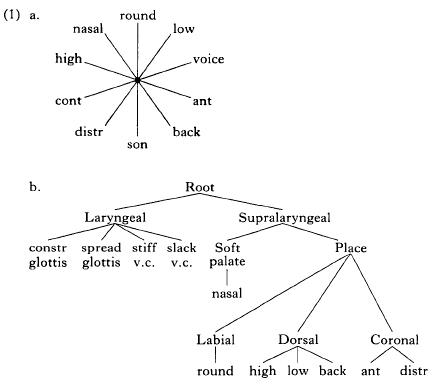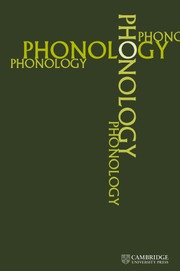Article contents
Vowel geometry*
Published online by Cambridge University Press: 20 October 2008
Extract
A basic assumption in current phonology is that features are not an unstructured set like (1a), but are arranged hierarchically into a constituent structure tree such as (1b), proposed in Sagey (1986: 61):

Other groupings of features have been proposed (Clements 1985; Steriade 1987; inter alii).
A fundamental assumption of theories like (1b) is that rules operate on constituents, an assumption which is formalised by limiting rules to spreading or delinking a single node.
- Type
- Articles
- Information
- Copyright
- Copyright © Cambridge University Press 1991
References
REFERENCES
Alpher, B. (1973). Son of ergative: the Yir Yoront language of Northeast Australia. PhD dissertation, Cornell University.Google Scholar
Archangeli, D. (1985). Yokuts harmony: evidence for coplanar representation in nonlinear phonology. LI 16. 335–372.Google Scholar
Archangeli, D. & Pulleyblank, D. (1987). Maximal and minimal rules: effects of tier scansion. NELS 17. 16–35.Google Scholar
Barker, M. A. R. (1963). Klamath dictionary. Berkeley & Los Angeles: University of California Press.Google Scholar
Barker, M. A. R. (1964). Klamath grammar. Berkeley & Los Angeles: University of California Press.Google Scholar
Brame, M. (1972). On the abstractness of phonology: Maltese S.. In Brame, M. (ed.) Contributions to generative phonology. Austin: University of Texas Press. 22–61.Google Scholar
Bright, W. (1972). The enunciative vowel. International Journal of Dravidian Linguistics 1. 26–55.Google Scholar
Carson, N. (1982) Phonology and morphology of Macuxi (Carib). PhD dissertation, University of Kansas.Google Scholar
Clements, G. N. (1974). Vowel harmony in Ewe. Studies in African Linguistics 5. 281–301.Google Scholar
Clements, G. N. (1985), The geometry of phonological features. Phonology Yearbook 2. 225–252.CrossRefGoogle Scholar
Clements, G. N. (1989). A unified set of features for consonants and vowels. Ms, Cornell University.Google Scholar
Clements, G. N. (1990). Place of articulation in consonants and vowels: a unified theory. To appear in Laks, B. & Rialland, A. (eds.) L'architecture et la géométrie des représentations phonologiques. Paris: CNRS.Google Scholar
Gudschinsky, S., Popovich, H. & Popovich, F. (1970). Native reaction and phonetic similarity in Maxakali phonology. Lg 46. 77–78.Google Scholar
Haas, M. (1940). Tunica. In Handbook of American Indian languages IV. New York: J. J. Augustin.Google Scholar
Haas, M. (1946). A grammatical sketch of Tunica. In Osgood, C. (ed.) Linguistic structures of native America. New York: The Viking Fund. 337–366.Google Scholar
Hammond, M. (1984). Constraining metrical theory: a modular theory of rhythm and destressing. PhD dissertation, UCLA.Google Scholar
Hume, E. (1990). Consonant/vowel interaction in Maltese and its implications for feature theory. To appear in WECOL 20.Google Scholar
Hyman, L. (1972). A phonological study of Fe?Fe? Bamileke. Studies in African Linguistics. Supplement 4.Google Scholar
Hyman, L. (1988). Underspecification and vowel height transfer in Esimbi. Phonology 5. 255–273.CrossRefGoogle Scholar
Hyman, L. (1989). Advanced tongue root in Kinande. Ms, University of California, Berkeley.Google Scholar
Ingemann, F. (1960). Morphophonemic alternations in Eastern Cheremis. In Sebeok (1960). 13–20.Google Scholar
Odden, D. (1977). Overspecification and variables in phonology. Linguistic Analysis 3. 177–196.Google Scholar
Pančvidze, V. N. & Džejranišvili, E. (1967). Udinskij jazyk. Jazyki Narodov SSSR IV: Iberijsko-Kavkazskie Jazyki. Moscow: Izdatelstvo Nauk.Google Scholar
Paradis, C. & Prunet, J.-F. (1989). On coronal transparency. Phonology 6. 317–348.CrossRefGoogle Scholar
Pulleyblank, E. (1989). The role of coronal in articulator based features. CLS 25. 379–393.Google Scholar
Sagey, E. (1986). The representation of features and relations in nonlinear phonology. PhD dissertation, MIT.Google Scholar
Sebeok, T. (ed.) (1960). American studies in Uralic linguistics. Bloomington: Indiana University Press.Google Scholar
Sebeok, T. & Ingemann, F. (1961). An Eastern Cheremis manual. Bloomington: Indiana University.Google Scholar
Valinande, N. (1984). The structure of Kinande. PhD dissertation, Georgetown University.Google Scholar
- 34
- Cited by


